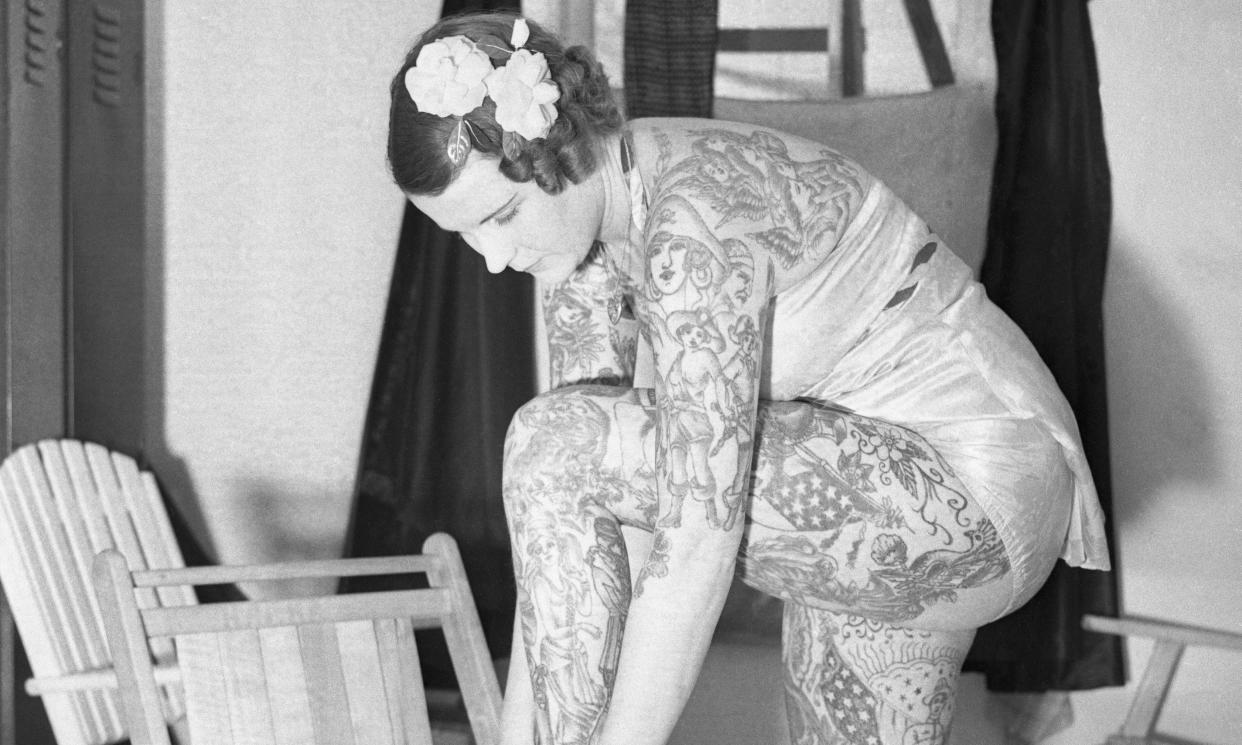The Illustrated Woman by Helen Mort – verse as indelible as tattoos

Poetry is more than skin deep, like the tattoos that are the subject of Helen Mort’s third collection. The Illustrated Woman explores tattoos through history and, lucid though these poems are, you need to reread them often to acquire the deepest sense of what is being said. Mort presents tattoos variously: as painful and cherished keepsakes, exposure and concealment combined, flirtations with indelibility.
There is a gazelle-like, glancing, shy quality to this writing before it resolves into the definite
Her emotions are elusive. In Love Poem, she likens her love to a landscape in which trees stand on the water’s edge like “hesitating divers”. In Night Rain, she says it has been observed that when she enters a room, she is “deer-like, tentative/ then definite.” She writes like this too – I found myself thinking of the 16th-century poet Thomas Wyatt’s beautiful line: “They flee from me that sometime did me seek”. There is a gazelle-like, glancing, shy quality to this writing before it resolves into the definite. Her poems are never overstated, journalistic or self-justifying, although one is invited to oversee several tattoos she has acquired and to consider why some women choose to wear their hearts on their skin.
Divided into three sections – Skin, Skinless and Skinned – First puts a first tattoo within the context of a first love affair:
… because of the virginity you took
and never knew, the meals you cooked
with aubergine and parmesan that made me feel
I could be your age. Because you let me
Undo my own buttons…
A flattering and possibly exploitative relationship is recalled without judgment, although she ends:
“this ink-shape levering from the hinge
of my spine, my first tattoo, was meant
to be a closing door
me turning my back
on you.”
The tattoo, addressed to others, seems also to be a note to self.
Betty Broadbent was the most photographed tattooed woman of the 20th century. Search online and you will find her densely dressed in ink. The New York Times quotes Broadbent claiming her pain was “worth it” but Mort’s poem offers no clue as to why. What one witnesses here is Mort’s mastery of the unforced ending: “her last designs on us”.
Other ways of making one’s mark on the world might, at a stretch, include children. Some marvellous and tender poems are dedicated to her little son, Alfie. Advent is beautifully achieved and describes his arrival on the first day of Christmas and there’s an amusing and unsettling antenatal prose poem, Into the Rucksack, about men learning, in an absurd-sounding class, how it feels to be pregnant. The rucksack becomes metaphorical as Mort guiltily considers her burden: “how it is lighter than some, into the rucksack goes my privilege, my inexplicable pain. Now the men are patting their fake bellies. Now they are taking the rucksack off again.” Once again, the unforced ending delivers: women lack the rucksack-shedding option.
Other outstanding poems include Precious, about a gold ring that movingly encircles three generations of women, This Is Wild, a prose poem about climbing glaciers in Greenland, in which the death wish and life wish seem interchangeable, and Deepfake: A Pornographic Ekphrastic. Mort, according to a BBC report, was once the victim of – and has campaigned against – someone uploading non-sexual images of her to a pornographic website for erotic modification. She sums up the hollow violence of her imagined site’s accompanying texts as “language reduced to words”. There is no such reduction elsewhere in her writing. Failsafe, the opening poem, includes this phrase to describe one of Vermeer’s women: “The bright risk of her stare.” Mort’s poems shine with bright risk throughout.
The Tattooed Lady by Helen Mort
‘It hurt something awful, but it was worth it’.
– BETTY BROADBENT, NEW YORK TIMES, 1939
Portrait of Betty at a beauty pageant, the wingspan
of her small black cape. Portrait of Betty lifting up her dress
to show her thighs. Portrait of the portrait of Pancho Villa
on her leg, Madonna almost smiling from her back.
Then Betty with a zebra at the circus, tight grip
on the fur tufting its neck. Betty naked,
wearing socks and sandals, seated,
with a crystal ball at stomach height.
Betty in another century, in miniature,
an outline on a younger woman’s arm,
or Betty at the end, her hands steepled
in front of her, her horn rimmed
spectacles and level stare,
her last designs on us.
The Illustrated Woman by Helen Mort is published by Chatto & Windus (£12.99). To support the Guardian and Observer order your copy at guardianbookshop.com. Delivery charges may apply


